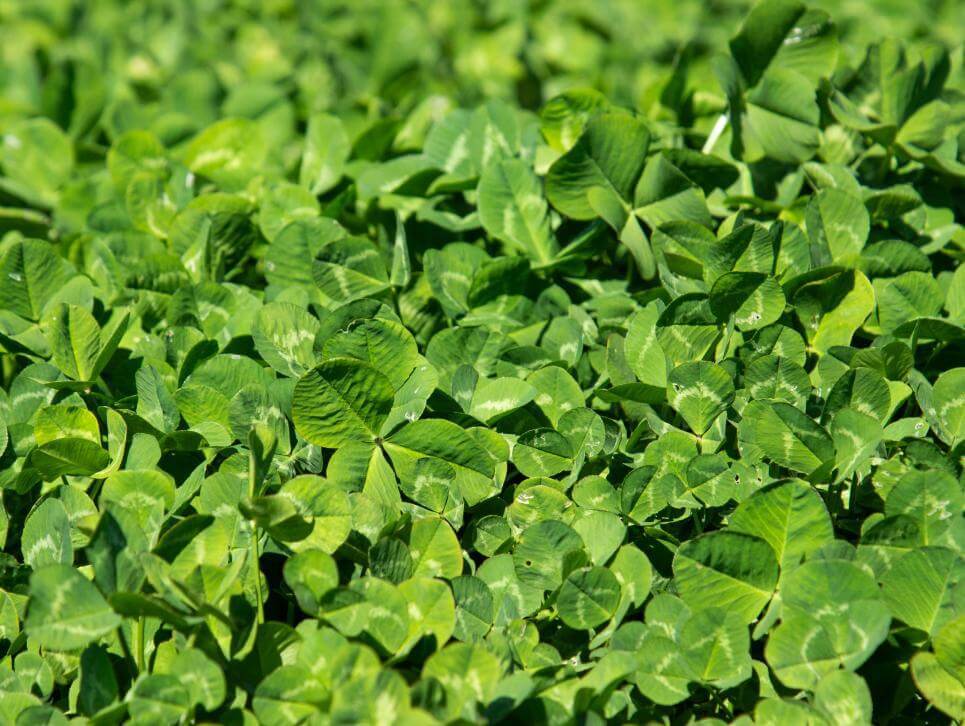Description
| Type: |
Perennial Legume |
Height: |
28 inches |
| Usage: |
Hay, Pasture |
Seeding Rate: |
5 lb/ acre |
| Plant: |
Feb- April
Sept- Oct |
Marco Polo Large Leaf White Clover Features
BIG LEAVES Marco Polo grows as tall as typical ladino clovers and boasts large leaves. WINTER ACTIVE Marco Polo was bred to be winter active, giving producers the advantage of higher total forage production for the year. Increased winter activity should also be beneficial for increasing fall wildlife activity.
Marco Polo has many uses including:
- BOOST PASTURE PRODUCTIVITY – Marco Polo can help lessen the effects of endophyte toxicity and contribute to overall herd health when planted into toxic endophyte pastures.
- NITROGEN AND PROTEIN BOOSTER – Marco Polo provides both nitrogen fixation and extra protein when sown with both cool-season and warm-season grasses.
- WILDLIFE/POLLINATORS – Marco Polo can be planted straight or as part of a mix for wildlife food plots and pollinator habitats. It will provide abundant, protein-rich feed and prolific flowers.
- EROSION CONTROL -Marco Polo’s vigorous root system reduces erosion.
- PERENNIAL COVER CROP – Marco Polo can be used in row crops, orchards, and others to fixate nitrogen, reduce weed pressure, and build soil health.
Before you plant – Marco Polo large leaf white clover performs best in soils with a pH of 6.0-6.5. It will also grow in semi-acidic soils as low as pH 5.0, on moist, well-drained, fertile soil. Seeding into deep sandy soils is not recommended. For optimal performance, conduct a soil test and follow the recommended lime and fertilizer recommendations. In established pastures, removing excess forage through grazing or late-season haying will help ensure successful seedling emergence and establishment. Reduce weed population prior to planting. Herbicide carryover/residual of chemicals applications prior to planting may harm plants.
When to plant – Plant in late fall when there is adequate moisture or early spring. Frost seeding also works well.
Seeding rate Planting as a pure stand on prepared seedbed: 5 lbs/acre. Planting as mixture with grasses on prepared seedbed: 1-2 lbs/acre. Planting into established grass pastures: 2-3 lbs/acre
Depth/Method – Plant at 1/8-1/4″ into a firm seedbed by broadcast or drill. Planting too deep may lead to poor establishment or stand failure. Cultipacking or dragging before and after seeding helps create a firm seedbed.
Fertilizing – At the time of seeding, apply lime, potassium, and phosphorus per soil test recommendation. No nitrogen is necessary. Inoculation – For optimal performance, Marco Polo should be pre-inoculated. Unless the seed has a Nitro-Coat® tag, be sure to inoculate with leguminosarum biovar trifolii rhizobium inoculant.
Management of Marco Polo large leaf white clover – Once established and properly managed, Marco Polo should provide numerous years of free nitrogen and protein-rich feed. Longevity will depend on location and management. Hotter regions with predominately warm-season species should last at least 1-2 years, while cooler climates should live 3-5 years, or longer. Broadcast 1 lb./acre of seed annually, or as needed. For pastures, a 25-30% clover percentage is recommended. Bloat is a concern for pastures exceeding 35% white clover.
The percentage of Marco Polo large leaf white clover in a stand can be managed using these tools: grazing or mowing height, fertilization, and reseeding. To increase the amount of Marco Polo, graze or mow more frequently at lower heights. This allows Marco Polo plants to increase their photosynthesis activity and excite more stolon growth. Regularly fertilize with nitrogen-free fertilizer based on soil test recommendations. Lastly, overseed thin areas with more Marco Polo.





